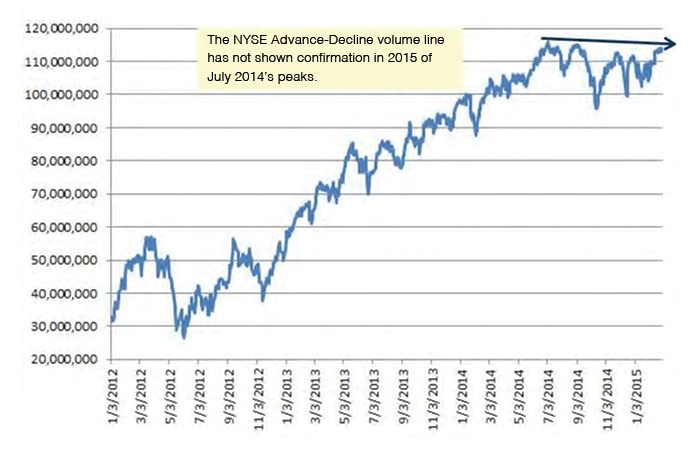
Despite the move to new market highs in Q1, the tactical backdrop continues to suggest a 5%-10% correction is likely, especially given the lack of conviction shown in the most recent rallies. The fundamental excuse for a pause in the upside is likely the anticipation of a 2Q15 Fed rate hike, but the good news is our fundamental core thesis demands investors use any meaningful correction as an opportunity to add equity exposure.
Lackluster demand was driving the market
Obviously, the market isn’t oversold, so the question becomes, was the move to Q1 highs strong enough to suggest significant and sustainable follow-through without experiencing a deeper correction? We doubt it based on some key indicators we track with our friends at the Lowry’s service:
Buying Power and Short-Term Index saw no oomph. The Lowry’s Buying Power and Short-Term Index measures NYSE composite market internals using price change, volume, and number of advancing issues. These indicators suggest that there was a lack of demand for stocks as the market made new all-time highs. The Buying Power Index remained below the recent peaks in November and December of 2014. Also, the Lowry’s Short-Term Index was closer to recent lows rather than recent highs. Generally, we look for these indicators to move higher as the market moves higher.
The NYSE cumulative volume advance-decline line did not confirm the market high. This indicator measures overall NYSE volume on a cumulative basis. When the NYSE closes higher, volume for that day is added, when the index closes lower, volume is subtracted (see chart).
NYSE CUMULATIVE VOLUME

Source: Cannacord Genuity
Summary
Given the consistency of the fundamental thesis, we must turn to tactical signs that would suggest the next leg higher. These signs are that the market needs to get oversold enough, or break out to the upside with conviction, in order to bring in significant and sustainable buyers. The Q1 move to new highs lacked the conviction that would cause a rush to buy.
The most recent near-term weakness has not been surprising, but it will ultimately make us more aggressive buyers as we believe the following: 1. Our core fundamental thesis is firmly in place. 2. We are a number of years away from recession risk. 3. A lack of investment alternatives should continue to drive investors to equities. 4. Historical precedent suggests a continuation in the current valuation expansion.
Given the solid fundamental backdrop, there are basically two reasons to be an aggressive buyer in a well-defined bull market:
- The market gets oversold enough using our key indicators, or
- There is enough of a thrust to new highs that causes investors to rush in.
There will clearly be more volatility and corrections along the way, but we remain focused on the intermediate-term opportunity rather than the near-term risk.
The opinions expressed in this article are those of the author and do not necessarily represent the views of Proactive Advisor Magazine. These opinions are presented for educational purposes only.
 Tony Dwyer is the head of the U.S. Macro Group and chief market strategist at Canaccord Genuity. He also sits on the firm’s U.S. operating committee. Mr. Dwyer joined Canaccord Genuity in 2012 and is known for the practical application of macroeconomic and tactical market indicators. Mr. Dwyer was previously equity strategist and director of research at Collins Stewart and a member of the firm's executive committee. Mr. Dwyer is a frequent guest on many financial news networks. canaccordgenuity.com
Tony Dwyer is the head of the U.S. Macro Group and chief market strategist at Canaccord Genuity. He also sits on the firm’s U.S. operating committee. Mr. Dwyer joined Canaccord Genuity in 2012 and is known for the practical application of macroeconomic and tactical market indicators. Mr. Dwyer was previously equity strategist and director of research at Collins Stewart and a member of the firm's executive committee. Mr. Dwyer is a frequent guest on many financial news networks. canaccordgenuity.com
Recent Posts:
